Have you ever found yourself frantically opening every cabinet door, searching for that one specific plate while your dinner grows cold? Or perhaps you’ve spent precious morning minutes hunting for a clean coffee mug while running late for work? If this sounds familiar, you’re not alone – and you’re about to discover how to end this daily frustration forever.
The truth is, kitchen organization isn’t just about making your space look pretty (though that’s a wonderful bonus). It’s about creating a system that works with your lifestyle, not against it. When your kitchen flows seamlessly, everything else in your daily routine becomes easier, more enjoyable, and significantly less stressful.
Why Kitchen Organization Changes Everything
Think about how much time you spend in your kitchen each day. Between morning coffee rituals, meal preparation, family gatherings, and late-night snack runs, this space serves as the heartbeat of your home. When it’s disorganized, that chaos ripples through your entire day.
Research shows that people who maintain organized kitchens spend 40% less time on meal preparation and report significantly lower stress levels during cooking. More importantly, they actually enjoy their time in the kitchen rather than dreading it.
Whether you’re living in a cozy apartment or a sprawling house, the principles of effective kitchen organization remain the same. It’s not about the size of your space – it’s about maximizing what you have and creating systems that actually work for your unique needs.
Start With Less: The Foundation of Smart Kitchen Organization
Before diving into organizational systems, let’s address the elephant in the room: you probably have too much stuff. The kitchen industry constantly tempts us with gadgets, tools, and beautiful accessories that promise to revolutionize our cooking experience. But here’s what they don’t tell you – more stuff often means more chaos.
The most organized kitchens follow a simple principle: keep only what you actually use regularly. This isn’t about minimalism for its own sake; it’s about kitchen storage efficiency and practicality.
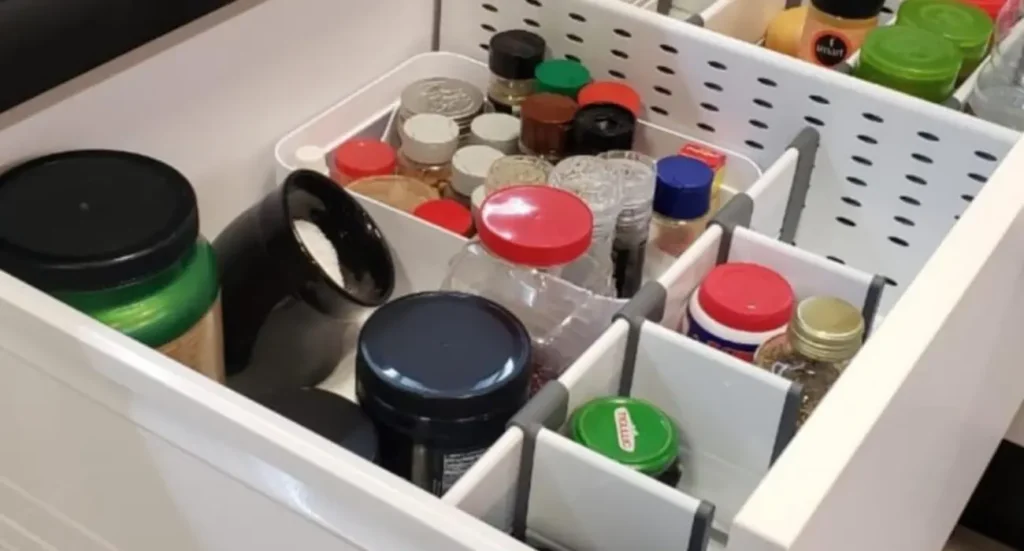
Ask yourself these questions about each item in your kitchen:
- Have I used this in the past six months?
- Does this serve a unique purpose I can’t accomplish with something else?
- Do I have multiple items that do the same job?
This decluttering process isn’t just about organization – it’s also about sustainability. Every item you don’t need is space, money, and mental energy you could use elsewhere.
Choose Your Organization Method and Stick With It
Professional organizers swear by two highly effective kitchen cabinet organization methods, and the key is picking one that matches your thinking style.
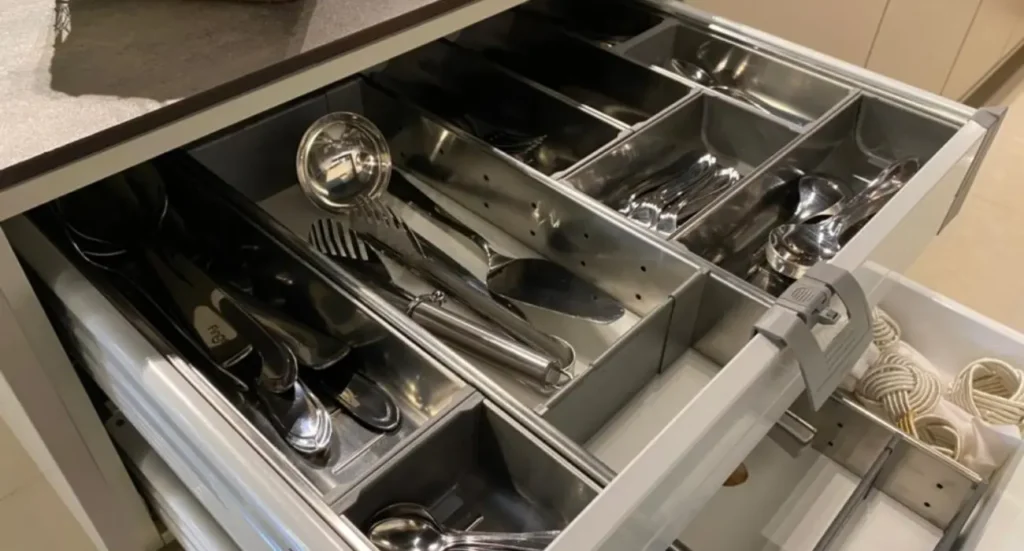
Method 1: Group by Category This approach keeps all similar items together. All plates with plates, all cups with cups, all cooking utensils in one designated area. This method works best for people who think categorically and prefer visual consistency.
Method 2: Group by Function This strategy combines frequently used items together, regardless of category. Your morning coffee setup might include mugs, spoons, sugar, and filters all in the same area. This method suits people who think in terms of tasks and routines.
The secret isn’t which method you choose – it’s consistency. Pick the approach that feels more natural to your thinking style and apply it throughout your entire kitchen. Mixing methods creates confusion and defeats the purpose of organization.
Maximize Drawer Space with Smart Dividers
Kitchen drawer organization can make or break your daily efficiency. Large drawers without internal structure become black holes where utensils disappear and frustration grows.
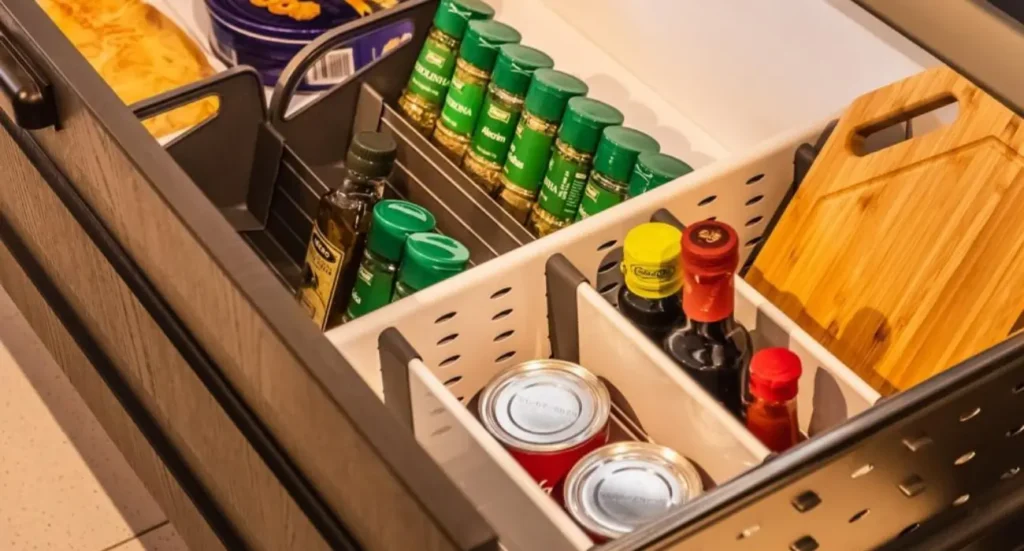
Drawer dividers are game-changers, but not all dividers are created equal. Adjustable dividers offer flexibility as your needs change, while fixed dividers provide long-term stability. Consider your cooking style and the types of utensils you use most frequently.
Materials matter too. Bamboo dividers are eco-friendly and naturally antimicrobial. Plastic options are budget-friendly and easy to clean. Metal dividers offer durability and a modern aesthetic. Choose based on your budget, cleaning preferences, and kitchen style.
The key is creating designated homes for everything. When each utensil has a specific place, you’ll naturally maintain organization because returning items becomes automatic.
Harness the Power of Containers and Baskets
Strategic container use transforms chaotic spaces into organized zones. But effective kitchen organization ideas go beyond just buying pretty containers – it’s about choosing the right container for each specific need.
Transparent containers work best for frequently accessed items because you can instantly see contents and quantities. This prevents overbuying and helps with meal planning. For pantry items, invest in airtight containers that keep food fresh longer.

Baskets excel at corralling small items that tend to scatter. Use them for produce, snack packages, or cleaning supplies. Metal baskets work well in industrial-style kitchens, while woven options add warmth to traditional spaces.
Consider where containers will live. Upper shelf containers should be lightweight and easy to grab. Lower cabinet containers can be heavier and larger. Counter containers should be beautiful enough to enhance your kitchen’s aesthetic.
Install Shelving That Actually Works
Open shelving has become incredibly popular, and for good reason – it provides immediate access to frequently used items while creating visual interest. But effective kitchen shelf organization requires strategy.
Reserve open shelving for items you use daily and don’t mind displaying. Beautiful dishes, frequently used spices, and attractive serving pieces work well. Store less attractive necessities in closed cabinets.
Consider your kitchen’s workflow when planning shelf placement. Shelving near the stove should hold cooking essentials. Shelving near the sink works well for dishes and cleaning supplies. This creates logical zones that support your cooking process.
Material choice affects both function and style. Wood shelving adds warmth but requires more maintenance. Metal shelving offers durability and a modern look. Glass shelving creates an open, airy feeling but shows every speck of dust.
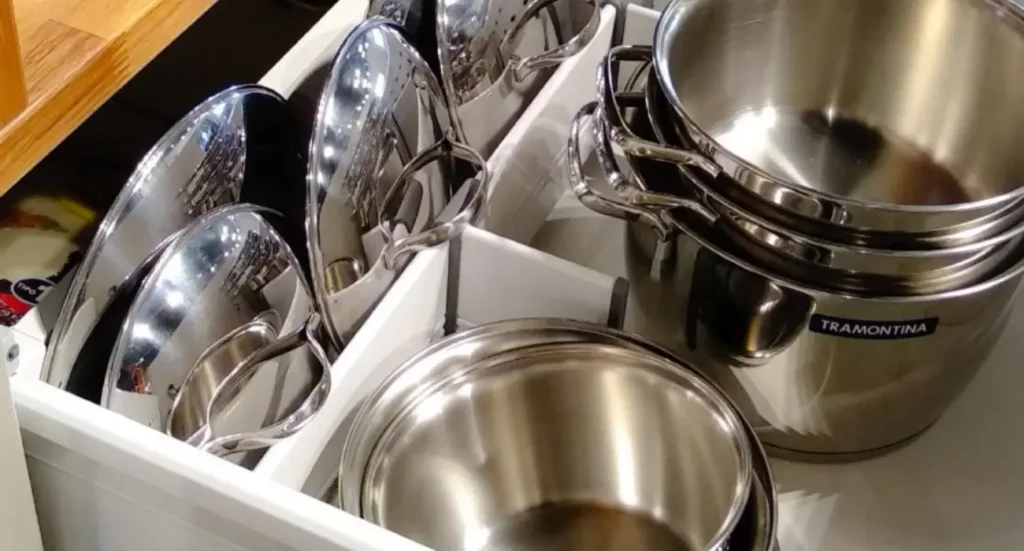
Create Flexible Workspace Solutions
Modern kitchens need adaptable solutions that work for both daily routines and special occasions. Folding tables and pull-out surfaces provide extra workspace when needed without permanently consuming valuable floor space.
Wall-mounted drop-down tables work perfectly in smaller kitchens. They provide prep space during cooking and can serve as casual dining areas. When not needed, they fold flat against the wall.
Rolling carts offer mobile workspace and storage. Use them as coffee stations, baking centers, or bar carts depending on your needs. Quality carts can move between kitchen and dining areas during entertaining.
The key is choosing solutions that truly fit your lifestyle. Don’t buy organization products just because they look good – invest in items that solve specific problems in your daily routine.
Master the Art of Vertical Storage
Most kitchens have significant unused vertical space, and smart kitchen storage solutions capitalize on this opportunity. Hooks, magnetic strips, and wall-mounted systems transform empty wall space into functional storage.
Hooks aren’t just for towels. Heavy-duty hooks can hold pots, pans, and even small appliances. Install them inside cabinet doors for cleaning supplies or measuring cups. Use them on backsplashes for utensils and tools.
Magnetic knife strips keep knives easily accessible while freeing up drawer space. However, consider safety if children frequently visit your home. Position magnetic strips high enough to be out of reach, or choose enclosed knife storage instead.
Vertical storage works best when it supports your cooking workflow. Place frequently used items at eye level, occasionally used items higher or lower, and rarely used items in the least accessible spots.
Keep Countertops Clear and Functional
Kitchen counter organization might be the most challenging aspect of kitchen management because counters serve multiple functions throughout the day. The key is distinguishing between items that deserve permanent counter space and items that should be stored elsewhere.
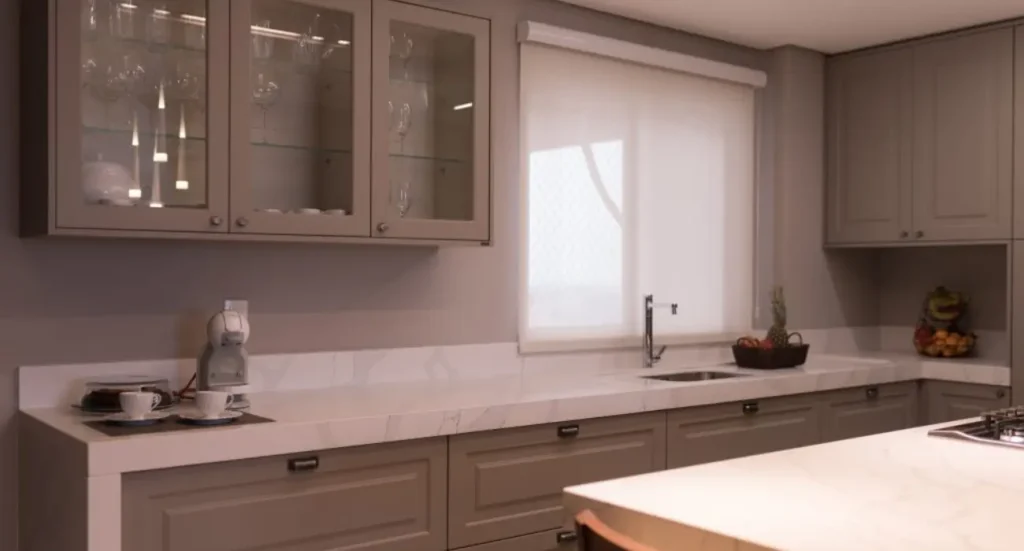
Earn their place on your counter by being used daily. Coffee makers, toasters, and knife blocks often qualify. Everything else should have a designated storage spot and only come out when needed.
Create designated zones on your counters. One area for coffee preparation, another for daily cooking, a third for mail and keys. This prevents counters from becoming catch-all spaces that accumulate clutter.
When counters do get cluttered, address it immediately. Clutter attracts more clutter, but clean surfaces stay clean longer. This simple habit maintains your organization system with minimal daily effort.
Design Pantry Storage That Actually Works
Effective pantry organization follows grocery store principles – group similar items together and place frequently used items at eye level. But your pantry should work better than any store because it’s customized for your specific needs.
Use the “first in, first out” rule to prevent food waste. Place newer items behind older ones so you naturally use items before they expire. This simple system can significantly reduce food waste and save money.
Categorize items in ways that make sense for your cooking style. Baking supplies together, breakfast items together, international ingredients together. Create categories that match how you actually cook and shop.
Label everything, even if you think you’ll remember. Labels help other family members maintain your system and make restocking groceries faster and more accurate.
Organize Dishes Like a Professional
Professional kitchens organize dishes for speed and safety, and these same principles work beautifully in home kitchens. Kitchen cabinet organization for dishes should prioritize both accessibility and protection.
Organize by size with larger items in back, smaller in front. This creates stability and makes everything visible at a glance. Stack similar items together – all dinner plates together, all salad plates together.
Create separate zones for different types of dishes. Everyday dishes should be easily accessible. Fine china can be stored higher or in less convenient locations. Serving pieces need easy access but don’t require daily convenience.
Consider how you actually use dishes when organizing. If you typically grab a plate and bowl together, store them near each other. If you always use specific glasses with certain meals, group them accordingly.
Perfect Your Glassware System
Glassware organization requires special attention because glasses are fragile and come in many sizes and shapes. Create a system that protects your investment while providing easy access.
Organize in rows by type and size. Heavy glasses in front, delicate glasses protected in back. Tall glasses on one side, short glasses on the other. This prevents accidents and makes selection intuitive.
Consider frequency of use when assigning locations. Daily-use glasses should be at comfortable reaching height. Special occasion glasses can be stored higher or in less convenient locations.
Use shelf liners or rubber mats to prevent sliding and provide cushioning. This simple addition can prevent many accidents and extend the life of your glassware.
Transform Your Kitchen Into Your Home’s Heart
When your kitchen organization system truly works, something magical happens. The space that once frustrated you becomes the heart of your home. Meal preparation becomes enjoyable rather than stressful. Family members naturally gather in this welcoming, functional space.
Remember, the best organizational system is the one you’ll actually maintain. Choose solutions that fit your lifestyle, budget, and aesthetic preferences. Start with small changes and build momentum rather than attempting a complete overhaul overnight.
Your kitchen should work for you, not against you. With these proven strategies, you’re well on your way to creating a space that supports your daily life while bringing you genuine joy.
Frequently Asked Questions
Q: How long does it take to organize a kitchen completely?
A: A complete kitchen organization project typically takes 2-3 days for most homes. However, you can tackle it in sections over several weekends. Start with one area, like cabinets or pantry, and build momentum from there.
Q: What’s the biggest mistake people make when organizing their kitchen?
A: The most common mistake is buying organization products before decluttering and planning. Start by removing items you don’t need, then observe how you actually use your kitchen before investing in storage solutions.
Q: How can I maintain kitchen organization with a busy family schedule?
A: Create simple systems that everyone can follow. Designate specific homes for everything, label clearly, and establish a “clean as you go” rule. Spend 10 minutes each evening returning items to their proper places to maintain your system effortlessly.

